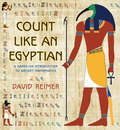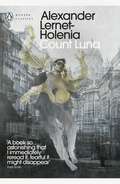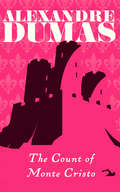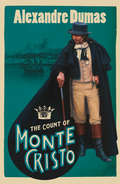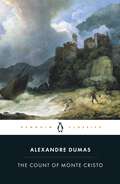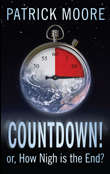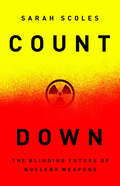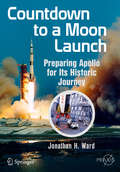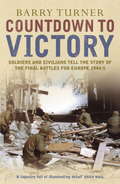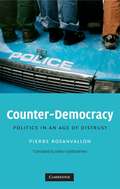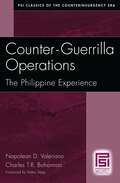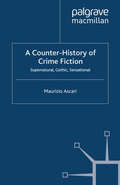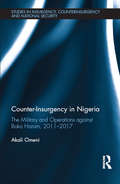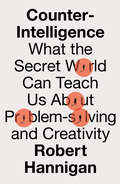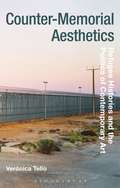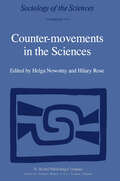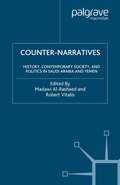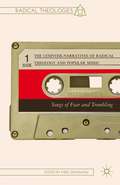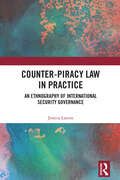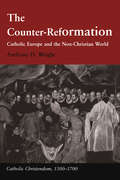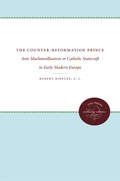- Table View
- List View
Count Like an Egyptian: A Hands-on Introduction to Ancient Mathematics (PDF)
by David ReimerThe mathematics of ancient Egypt was fundamentally different from our math today. Contrary to what people might think, it wasn't a primitive forerunner of modern mathematics. In fact, it can’t be understood using our current computational methods. Count Like an Egyptian provides a fun, hands-on introduction to the intuitive and often-surprising art of ancient Egyptian math. David Reimer guides you step-by-step through addition, subtraction, multiplication, and more. He even shows you how fractions and decimals may have been calculated—they technically didn’t exist in the land of the pharaohs. You’ll be counting like an Egyptian in no time, and along the way you’ll learn firsthand how mathematics is an expression of the culture that uses it, and why there’s more to math than rote memorization and bewildering abstraction.Reimer takes you on a lively and entertaining tour of the ancient Egyptian world, providing rich historical details and amusing anecdotes as he presents a host of mathematical problems drawn from different eras of the Egyptian past. Each of these problems is like a tantalizing puzzle, often with a beautiful and elegant solution. As you solve them, you’ll be immersed in many facets of Egyptian life, from hieroglyphs and pyramid building to agriculture, religion, and even bread baking and beer brewing.Fully illustrated in color throughout, Count Like an Egyptian also teaches you some Babylonian computation—the precursor to our modern system—and compares ancient Egyptian mathematics to today’s math, letting you decide for yourself which is better.
Count Luna
by Alexander Lernet-Holenia'A book so astonishing that I immediately reread it, fearful it might disappear' Patti SmithThe war is over but Alexander Jessiersky, a wealthy Austrian aristocrat and industrialist, is haunted by guilt over the neighbour he inadvertently sent to a concentration camp, Count Luna. What's more, he is convinced that Luna survived - and is out to get his revenge. So begins a wild, weird cat-and-mouse chase that takes him and his shadowy nemesis through windswept valleys, eerie houses and, eventually, Rome's catacombs, as an increasingly paranoid Jessiersky asks himself: will Luna stop at nothing to exact his bloody vengeance? Crazed, raging and darkly comic, Count Luna is a reckoning with postwar guilt, and an irresistible tale of the uncanny.'Like Kafka ... Lernet-Holenia weaves his most intimate hopes and dreams ... with exquisitely imagined detail' Chicago Tribune
The Count of Monte Cristo: In English Translation
by Alexandre DumasImprisoned for a crime he didn’t commit, Edmond Dantès spends fourteen bitter years in a dungeon. When his daring escape plan works he uses all he has learnt during his incarceration to mastermind an elaborate plan of revenge that will bring punishment to those responsible for his fate. No longer the naïve sailor who disappeared into the dark fortress all those years ago, he reinvents himself as the powerful Count of Monte Cristo.Penguin Random House Canada is proud to bring you classic works of literature in e-book form, with the highest quality production values. Find more today and rediscover books you never knew you loved.
The Count of Monte Cristo: In English Translation
by Alexandre DumasThe ultimate story of escape to riches, revenge and redemption by ‘the Napoleon of storytellers’.
The Count of Monte Cristo: In English Translation
by Alexandre DumasThe epic tale of wrongful imprisonment, adventure and revenge, in its definitive translationThrown in prison for a crime he has not committed, Edmond Dantès is confined to the grim fortress of If. There he learns of a great hoard of treasure hidden on the Isle of Monte Cristo and he becomes determined not only to escape, but also to use the treasure to plot the destruction of the three men responsible for his incarceration. Dumas' epic tale of suffering and retribution, inspired by a real-life case of wrongful imprisonment, was a huge popular success when it was first serialized in the 1840s.Translated with an Introduction by ROBIN BUSS
Countdown!: Or, How Nigh is the End?
by Sir Patrick MoorePatrick Moore is Britain's most respected and best-loved astronomer. In Countdown! he examines the multifarious theories of how and when the world will end, from St Augustine to the Millennium Bug, via Nostradamus. With a healthy dose of irreverent humour, he investigates and dismisses the weird and wonderful predictions of sometimes imminent cataclysm, before turning to the science of what might really happen (a long, long time in the future, thankfully). Written with his trademark combination of wit and accessible science, and updated to include the latest theories on asteroids and climate change, this is a must-read book for anyone with an interest in popular science in general, and how the world might end in particular.
Countdown: The Blinding Future of Nuclear Weapons
by Sarah ScolesFor fans of Oppenheimer, a riveting investigation into the modern nuclear weapons landscape. Nuclear weapons are, today, as important as they were during the Cold War, and some experts say we could be as close to a nuclear catastrophe now as we were at the height of that conflict. Despite that, conversations about these bombs generally often happen in past tense. In Countdown, science journalist Sarah Scoles uncovers a different atomic reality: the nuclear age&’s present. Drawing from years of on-the-ground reporting at the nation's nuclear weapons labs, Scoles interrogates the idea that having nuclear weapons keeps us safe, deterring attacks and preventing radioactive warfare. She deftly assesses the existing nuclear apparatus in the United States, taking readers beyond the news headlines and policy-speak to reveal the state of nuclear-weapons technology, as well as how people currently working within the U.S. nuclear weapons complex have come to think about these bombs and the idea that someone, someday, might use them. Through a sharp, surprising, and undoubtedly urgent narrative, Scoles brings us out of the Cold War and into the twenty-first century, opening readers' eyes to the true nature of nuclear weapons and their caretakers while also giving us the context necessary to understand the consequences of their existence, for worse and for better, for now and for the future.
Countdown to a Moon Launch: Preparing Apollo for Its Historic Journey (Springer Praxis Books)
by Jonathan H. WardThousands of workers labored at Kennedy Space Center around the clock, seven days a week, for half a year to prepare a mission for the liftoff of Apollo 11. This is the story of what went on during those hectic six months.Countdown to a Moon Launch provides an in-depth look at the carefully choreographed workflow for an Apollo mission at KSC. Using the Apollo 11 mission as an example, readers will learn what went on day by day to transform partially completed stages and crates of parts into a ready-to-fly Saturn V. Firsthand accounts of launch pad accidents, near misses, suspected sabotage, and last-minute changes to hardware are told by more than 70 NASA employees and its contractors. A companion to Rocket Ranch, it includes many diagrams and photographs, some never before published, to illustrate all aspects of the process. NASA’s groundbreaking use of computers for testing and advanced management techniques are also covered in detail.This book will demystify the question of how NASA could build and launch Apollo missions using 1960s technology. You’ll discover that there was no magic involved – just an abundance of discipline, willpower, and creativity.
Countdown to Victory: The Final European Campaigns Of World War Ii (P. S. Series)
by Barry TurnerIn standard histories of the Second World War, the last six months in the western European arena invariably make a short epilogue. After the German failure in the Battle of the Bulge, Hitler's bold counter attack across the Ardennes, the war is often assumed to have been all over bar sporadic shooting. This was far from the truth; it was certainly not how those soldiers and civilians at the front saw it. Drawing on American, British, Canadian, German, Dutch and Scandinavian sources, most of them previously unpublished, and starting with the Battle of the Bulge, COUNTDOWN TO VICTORY tells the little known story of those final months through the eyes of ordinary people who had to live the trauma.
Counter-democracy: Politics In An Age Of Distrust (The\seeley Lectures #7 (PDF))
by Pierre Rosanvallon Arthur GoldhammerDemocracy is established as a generally uncontested ideal, while regimes inspired by this form of government fall under constant criticism. Hence, the steady erosion of confidence in representatives that has become one of the major political issues of our time. Amidst these challenges, the paradox remains that while citizens are less likely to make the trip to the ballot box, the world is far from entering a phase of general political apathy. Demonstrations and activism abound in the streets, in cities across the globe and on the internet. Pierre Rosanvallon analyses the mechanisms used to register a citizen's expression of confidence or distrust, and then focuses on the role that distrust plays in democracy from both a historical and theoretical perspective. This radical shift in perspective uncovers a series of practices - surveillance, prevention, and judgement - through which society corrects and exerts pressure.
Counter-Guerrilla Operations: The Philippine Experience (PSI Classics of the Counterinsurgency Era)
by Napolean D. Valeriano Charles T.R. BohannanThis volume in the Praeger Security International (PSI) series Classics of the Counterinsurgency Era by two officers-one from the Philippines and the other from America-who fought as guerrillas against the Japanese occupation and went on to defeat the Huk rebellion after World War II. Unlike many other accounts of counterinsurgency operations that focus on theoretical principles and their tactical applications, the authors examine the means to assess the strengths and weaknesses of insurgencies. An enduring contribution of this book is its emphasis on the importance of intelligence in combating insurgent movements. With a new foreword prepared by Kalev Sepp.
A Counter-History of Crime Fiction: Supernatural, Gothic, Sensational (Crime Files)
by Maurizio AscariThis book takes a look at the evolution of crime fiction. Considering 'criminography' as a system of inter-related sub-genres, it explores the connections between modes of literature such as revenge tragedies, the gothic and anarchist fiction, while taking into account the influence of pseudo-sciences such as mesmerism and criminal anthropology.
Counter-Insurgency in Nigeria: The Military and Operations against Boko Haram, 2011-2017 (Studies in Insurgency, Counterinsurgency and National Security)
by Akali OmeniThis book offers a detailed examination of the counter-insurgency operations undertaken by the Nigerian military against Boko Haram between 2011 and 2017. Based on extensive fieldwork conducted with military units in Nigeria, Counter-Insurgency in Nigeria has two main aims. First, it seeks to provide an understanding of the Nigerian military’s internal role – a role that today, as a result of internal threats, pivots towards counter-insurgency. The book illustrates how organizational culture, historical experience, institutions, and doctrine, are critical to understanding the Nigerian military and its attitudes and actions against the threat of civil disobedience, today and in the past. The second aim of the book is to examine the Nigerian military campaign against Boko Haram insurgents – specifically, plans and operations between June 2011 and April 2017. Within this second theme, emphasis is placed on the idea of battlefield innovation and the reorganization within the Nigerian military since 2013, as the Nigerian Army and Air Force recalibrated themselves for COIN warfare. A certain mystique has surrounded the technicalities of COIN operations by the Army against Boko Haram, and this book aims to disperse that veil of secrecy. Furthermore, the work’s analysis of the air force’s role in counter-insurgency is unprecedented within the literature on military warfare in Nigeria. This book will be of great interest to students of military studies, counter-insurgency, counter-terrorism, African politics and security studies in general.
Counter-Insurgency in Nigeria: The Military and Operations against Boko Haram, 2011-2017 (Studies in Insurgency, Counterinsurgency and National Security)
by Akali OmeniThis book offers a detailed examination of the counter-insurgency operations undertaken by the Nigerian military against Boko Haram between 2011 and 2017. Based on extensive fieldwork conducted with military units in Nigeria, Counter-Insurgency in Nigeria has two main aims. First, it seeks to provide an understanding of the Nigerian military’s internal role – a role that today, as a result of internal threats, pivots towards counter-insurgency. The book illustrates how organizational culture, historical experience, institutions, and doctrine, are critical to understanding the Nigerian military and its attitudes and actions against the threat of civil disobedience, today and in the past. The second aim of the book is to examine the Nigerian military campaign against Boko Haram insurgents – specifically, plans and operations between June 2011 and April 2017. Within this second theme, emphasis is placed on the idea of battlefield innovation and the reorganization within the Nigerian military since 2013, as the Nigerian Army and Air Force recalibrated themselves for COIN warfare. A certain mystique has surrounded the technicalities of COIN operations by the Army against Boko Haram, and this book aims to disperse that veil of secrecy. Furthermore, the work’s analysis of the air force’s role in counter-insurgency is unprecedented within the literature on military warfare in Nigeria. This book will be of great interest to students of military studies, counter-insurgency, counter-terrorism, African politics and security studies in general.
Counter-Intelligence: What the Secret World Can Teach Us About Problem-solving and Creativity
by null Robert HanniganFrom the codebreakers and problem solvers, to the engineers, mathematicians and other problem-solvers – what the secret world can teach us about performance and creativity How do you hire smart people who can work together to prevent terrorist attacks and decode encrypted technology? How do you come up with creative, counterintuitive solutions to solve major global problems? How do you provide the right environment for these people to thrive and work at their best when under immense pressure? Written by Robert Hannigan, the former Director of GCHQ, this book explores the role of the counter-intelligence services in history and today’s world – from the codebreakers and problem solvers, to innovation and creativity, secrecy and transparency and the global tech community. It will trace the history of counter-intelligence – from the early days of Bletchley Park, to the ongoing work of GCHQ – while reflecting on some of the unique characteristics of the engineers, mathematicians and other problem-solvers that make up the world’s intelligence community. An exhaustive and authoritative account of the history of counter-intelligence from Bletchley Park to modern day GCHQ, this brilliant and unique book will appeal to business readers, history readers and fans of smart thinking and big ideas around the world.
Counter-Memorial Aesthetics: Refugee Histories and the Politics of Contemporary Art (Radical Aesthetics-Radical Art)
by Veronica TelloRestrictive border protection policies directed toward managing the flow of refugees coming into neoliberal democracies (and out of failing nation-states) are a defining feature of contemporary politics. In this book, Verónica Tello analyses how contemporary artists-such as Tania Bruguera, Isaac Julien, Rosemary Laing, Dinh Q. Lé, Dierk Schmidt, Hito Steyerl, Lyndell Brown and Charles Green-negotiate their diverse subject positions while addressing and taking part in the production of images associated with refugee experiences and histories. Tello argues that their practices, which manifest across a range of contexts including Cuba, the United States, Australia and Europe, represent an emergent, global paradigm of contemporary art, 'counter-memorial aesthetics'. Counter-Memorial Aesthetics, Tello argues, is characterized by its conjunction of heterogeneous signifiers and voices of many times and places, generating an experimental, non-teleological approach to the construction of contemporary history, which also takes into account the complex, disorienting spatial affects of globalization. Spanning performance art, experimental 'history painting', aftermath photography and video installation, counter-memorial aesthetics bring to the fore, Tello argues, how contemporary refugee flows and related traumatic events critically challenge and conflict with many existing, tired if not also stubborn notions of national identity, borders, history and memory. Building on the writings of such thinkers as Michel Foucault and Jacques Rancière, this book offers a useful concept of 'counter-memory' for the twenty-first century. It shows how counter-memorial aesthetics is not only central to the nexus of contemporary art and refugee histories but also how it can offer a way of being critically present with many other, often interrelated, global crises in the contemporary era.
Counter-Memorial Aesthetics: Refugee Histories and the Politics of Contemporary Art (Radical Aesthetics-Radical Art)
by Veronica TelloRestrictive border protection policies directed toward managing the flow of refugees coming into neoliberal democracies (and out of failing nation-states) are a defining feature of contemporary politics. In this book, Verónica Tello analyses how contemporary artists-such as Tania Bruguera, Isaac Julien, Rosemary Laing, Dinh Q. Lé, Dierk Schmidt, Hito Steyerl, Lyndell Brown and Charles Green-negotiate their diverse subject positions while addressing and taking part in the production of images associated with refugee experiences and histories. Tello argues that their practices, which manifest across a range of contexts including Cuba, the United States, Australia and Europe, represent an emergent, global paradigm of contemporary art, 'counter-memorial aesthetics'. Counter-Memorial Aesthetics, Tello argues, is characterized by its conjunction of heterogeneous signifiers and voices of many times and places, generating an experimental, non-teleological approach to the construction of contemporary history, which also takes into account the complex, disorienting spatial affects of globalization. Spanning performance art, experimental 'history painting', aftermath photography and video installation, counter-memorial aesthetics bring to the fore, Tello argues, how contemporary refugee flows and related traumatic events critically challenge and conflict with many existing, tired if not also stubborn notions of national identity, borders, history and memory. Building on the writings of such thinkers as Michel Foucault and Jacques Rancière, this book offers a useful concept of 'counter-memory' for the twenty-first century. It shows how counter-memorial aesthetics is not only central to the nexus of contemporary art and refugee histories but also how it can offer a way of being critically present with many other, often interrelated, global crises in the contemporary era.
Counter-Movements in the Sciences: The Sociology of the Alternatives to Big Science (Sociology of the Sciences Yearbook #3)
by Helga Nowotny and Hilary RoseHeretical thoughts in an orthodox series on sociology of the sciences? Devils and science between the covers of one book? Games with ambivalence to mask collective uncertainty? We anticipate similar future reactions from readers or reviewers when assessing the way in which this volume has been assembled. But writings on counter-science, like the history of colonialism, are usually written by the winners, therefore unequivocally partial and only too often lacking in social imagination. In seeking to redress the balance, we admit to having been fully receptive to the latter, of having displayed an un measured degree of sympathy with heretics and outsiders, including practising scientists, and to letting science defend itself. The antithetical relationship implied in the volume's title - Counter-movements in the Sciences - stands for what we regard as an ongoing, open-ended process. In collecting material for this volume, we have brought together voices speaking from different quarters: there are those who, although modestly claiming to speak only for them selves, have set out to question sacred assumptions of scientific faith or to cast doubt on well-known claims scientific knowledge holds over other forms of knowledge; others have undertaken to demonstrate the fragility, ifnot untenability of attempts at demarcation between science and other systems of belief or practice or shown that demarcations between different forms of rationality rest on other than methodological grounds; finally, those who wish to re-arrange, by mapping out some meta-point of surveillance, familiar territory, showing the need for rearrangement and
Counter-Narratives: History, Contemporary Society, and Politics in Saudi Arabia and Yemen
by M. Al-Rasheed R. VitalisSaudi Arabia and Yemen are two countries of crucial importance in the Middle East and yet our knowledge about them is highly limited, while typical ways of looking at the histories of these countries have impeded understanding. Counter-Narratives brings together a group of leading scholars of the Middle East using new theoretical and methodological approaches to cross-examine standard stories, whether as told by Westerners or by Saudis and Yemenis, and these are found wanting. The authors assess how grand historical narratives such as those produced by states and colonial powers are currently challenged by multiple historical actors, a process which generates alternative narratives about identity, the state and society.
The Counter-Narratives of Radical Theology and Popular Music: Songs of Fear and Trembling (Radical Theologies and Philosophies)
by Mike GrimshawIn this unique collection, theologians born and formed during the Cold War offer their insights and perspectives on theological relationships with such musical artists and groups as Joy Division, U2, Nick Cave, and John Coltrane. These essays demonstrate that one's personal music preferences can inform and influence professional interests.
Counter-Piracy Law in Practice: An Ethnography of International Security Governance
by Jessica LarsenThis book is a socio-legal study of counter-piracy. It takes as its case the law enforcement efforts after 2008 to suppress piracy off the coast of Somalia. Through ethnographic fieldwork, the book invites the reader onto a Danish warship patrolling the western Indian Ocean for piracy incidents and into the courtroom in Seychelles, where more than 150 suspects were prosecuted. The aim is to understand how counter-piracy worked in practice. The book uses assemblage theory to approach law as a social process and places emphasis on studying empirical enforcement practices over analysing legal provisions. This supplements existing scholarship on the legal aspects of counter-piracy. Scholarship has mainly examined applicable law governing counter-piracy. This book steps into the field to examine applied law. Its methodology renders visible areas of legal ambiguity and identifies practices that suggest impunity and question legal certainty. It thus contributes with new policy-relevant knowledge for international security governance. The relevance is one of urgency. Counter-piracy off Somalia has served as a governance paradigm, which is replicated in other maritime domains. Consideration of the implications for policy is therefore needed. The book will be of interest to policy-makers, security practitioners and scholars who share a methodological commitment to practice.
Counter-Piracy Law in Practice: An Ethnography of International Security Governance
by Jessica LarsenThis book is a socio-legal study of counter-piracy. It takes as its case the law enforcement efforts after 2008 to suppress piracy off the coast of Somalia. Through ethnographic fieldwork, the book invites the reader onto a Danish warship patrolling the western Indian Ocean for piracy incidents and into the courtroom in Seychelles, where more than 150 suspects were prosecuted. The aim is to understand how counter-piracy worked in practice. The book uses assemblage theory to approach law as a social process and places emphasis on studying empirical enforcement practices over analysing legal provisions. This supplements existing scholarship on the legal aspects of counter-piracy. Scholarship has mainly examined applicable law governing counter-piracy. This book steps into the field to examine applied law. Its methodology renders visible areas of legal ambiguity and identifies practices that suggest impunity and question legal certainty. It thus contributes with new policy-relevant knowledge for international security governance. The relevance is one of urgency. Counter-piracy off Somalia has served as a governance paradigm, which is replicated in other maritime domains. Consideration of the implications for policy is therefore needed. The book will be of interest to policy-makers, security practitioners and scholars who share a methodological commitment to practice.
The Counter-Reformation: Catholic Europe and the Non-Christian World (Catholic Christendom, 1300-1700)
by Anthony D. WrightModern scholarship has effectively demonstrated that, far from being a knee-jerk reaction to the challenges of Protestantism, the Catholic Reformation of the sixteenth and seventeenth centuries was fuelled primarily by a desire within the Church to reform its medieval legacy and to re-enthuse its institutions with a sense of religious zeal. In many ways, both the Protestant and Catholic Reformations were inspired by the same humanist ideals and though ultimately expressed in different ways, the origins of both movements can be traced back to the patristic revival of the fifteenth and sixteenth centuries. Nevertheless, it is undeniable that many contemporaries, and subsequent historians, came to view the Catholic Reformation as an attempt to challenge the Protestants and to cut the ground from beneath their feet. In this new revised edition of Dr Wright's groundbreaking study of the Counter-Reformation, the wide panoply of the Catholic Reformation is spread out and analysed within the political, religious, philosophical, scientific and cultural context of late medieval and early modern Europe. In so doing, this book provides a fascinating guide to the many doctrinal and interrelated social issues involved in the wholesale restructuring of religion that took place both within Western Europe and overseas.
The Counter-Reformation: Catholic Europe and the Non-Christian World (Catholic Christendom, 1300-1700)
by Anthony D. WrightModern scholarship has effectively demonstrated that, far from being a knee-jerk reaction to the challenges of Protestantism, the Catholic Reformation of the sixteenth and seventeenth centuries was fuelled primarily by a desire within the Church to reform its medieval legacy and to re-enthuse its institutions with a sense of religious zeal. In many ways, both the Protestant and Catholic Reformations were inspired by the same humanist ideals and though ultimately expressed in different ways, the origins of both movements can be traced back to the patristic revival of the fifteenth and sixteenth centuries. Nevertheless, it is undeniable that many contemporaries, and subsequent historians, came to view the Catholic Reformation as an attempt to challenge the Protestants and to cut the ground from beneath their feet. In this new revised edition of Dr Wright's groundbreaking study of the Counter-Reformation, the wide panoply of the Catholic Reformation is spread out and analysed within the political, religious, philosophical, scientific and cultural context of late medieval and early modern Europe. In so doing, this book provides a fascinating guide to the many doctrinal and interrelated social issues involved in the wholesale restructuring of religion that took place both within Western Europe and overseas.
The Counter-Reformation Prince: Anti-Machiavellianism or Catholic Statecraft in Early Modern Europe
by Robert BireleyBireley explores the anti-Machavellian tradition of sixteenth- and seventeenth-century Europe and the writers who cultivated it, including Giovanni Botero and Justus Lipsius. The tradition produced an international political literature that is immensely important for understanding the Counter-Reformation, Baroque culture, and early modern politics and diplomacy.Originally published in 1990.A UNC Press Enduring Edition -- UNC Press Enduring Editions use the latest in digital technology to make available again books from our distinguished backlist that were previously out of print. These editions are published unaltered from the original, and are presented in affordable paperback formats, bringing readers both historical and cultural value.
